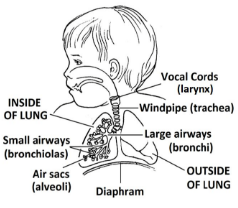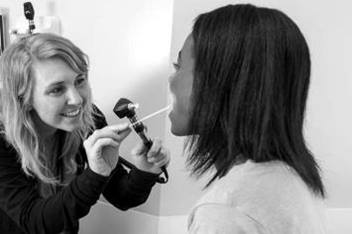Tracheomalacia
![]()
Tracheomalacia (tray key oh mah LAY she ah) means that the walls of a child’s windpipe (trachea) collapse (fall in on themselves). This can happen because the walls of the windpipe are weak, or it can happen because something is pressing on it. The whole windpipe can be affected, or only a short piece of it. If the collapsed part of the windpipe goes past the area where the windpipe branches off into the two lungs, it is called bronchomalacia (brahn koh mah LAY she ah).
This problem causes noisy or difficult breathing in the first 1 to 2 months after birth. This is called congenital tracheomalacia (it was present at birth). It is not very common. Babies born with tracheomalacia may have other health issues like a heart defect, reflux or developmental delay. Some children get tracheomalacia because of other health issues. Symptoms can be mild to severe.
Symptoms

- Noisy breathing that may get better when you change your baby’s position or while he or she is asleep.
- Breathing problems that get worse during coughing, crying, feeding or colds.
- High-pitched sound during breathing (stridor).
- High-pitched cough.
- Rattling noise or wheezing with breathing.
Diagnosis
If your baby’s doctor thinks your child may have this problem, he or she may order tests. Some tests that the doctor might use to learn if your baby has tracheomalacia:
- X-ray or CT scan of the chest.
- Airway Fluoroscopy (floor OSS koh pee) to look at the windpipe (trachea).
- Direct Laryngoscopy (LAYR inn GOSS koh pee) to look at the vocal cords (larynx).
- Bronchoscopy (BRAHN koh SKAH pee) to look at the airways in the lungs (bronchi).
If your child is diagnosed with tracheomalacia, the doctor may suggest other tests to find out the cause, or decide on the best treatment.
Treatment
Your baby’s noisy breathing and breathing problems will get better with time. As he or she grows, the walls of the trachea get stronger. It may take years until the problems are completely gone. Until then, your baby will breathe better if you use a humidifier. Your child’s doctor may prescribe medicine that can lower the amount of mucous or inflammation (swelling) in the windpipe.
A cough or cold that may only cause mild problems for other children may cause severe symptoms for a child with tracheomalacia. Your child may need special treatment or medicines, or even need to go to the hospital.
If tracheomalacia is caused by something pressing in on the windpipe, your child’s doctor may recommend other therapies, or even surgery. A whole team of doctors may be part of your child’s care. These doctors have special skills in the treatment of the lungs, heart, ears, nose and throat, or in chest surgery.
Symptoms of tracheomalacia are usually gone by the time your baby is 18 to 24 months old. Surgery is rarely needed.
When to Call the Doctor
Call your child’s doctor if:
- Your baby has difficulty breathing.
- Your baby is not gaining weight.
- Your baby has other symptoms that concern you.
If you have questions, please call our Nurse Line at 614-722-6547.
HH-I-335 Revised 2/15 Copyright 2011 Nationwide Children’s Hospital

